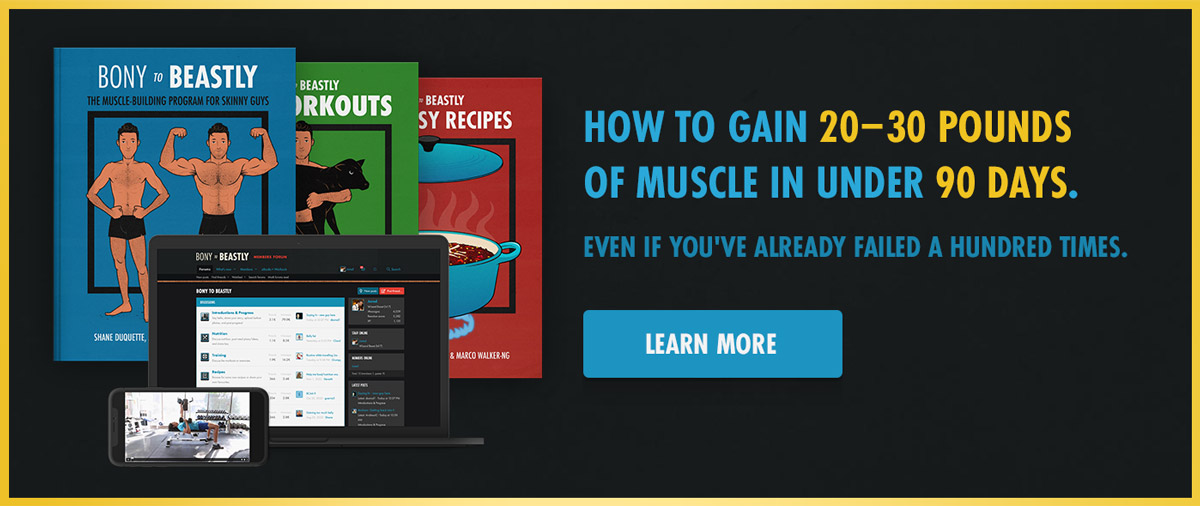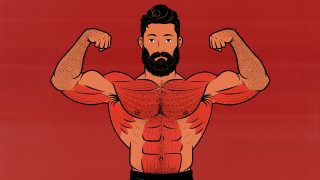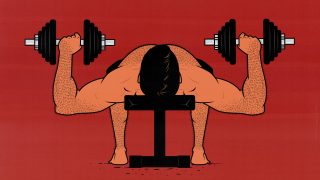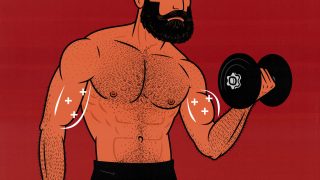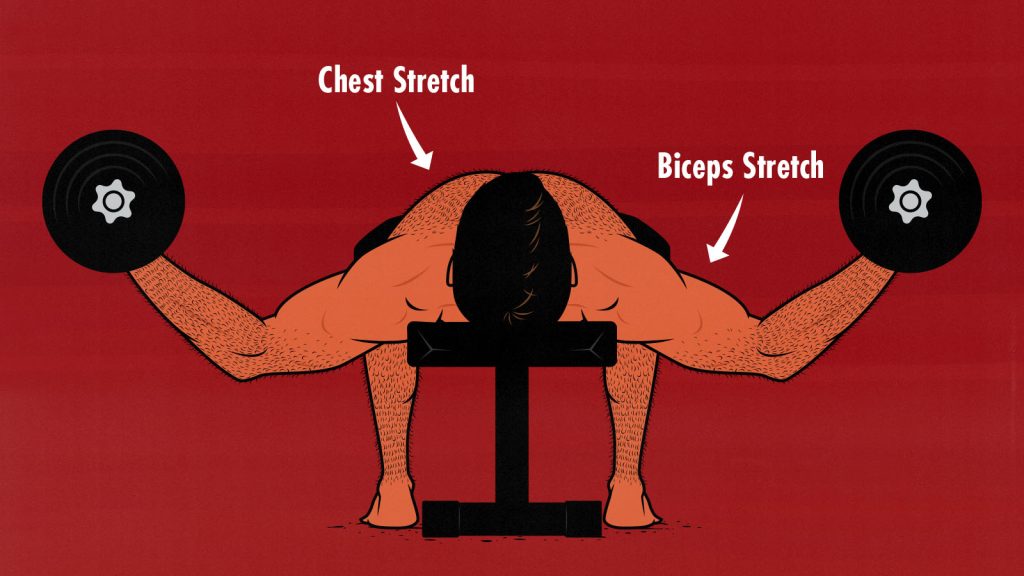
The Chest & Biceps Workout (Strange but Powerful)
Chest and biceps aren’t usually trained together in the same workout. It’s far more common to pair the chest with triceps and the back with biceps. It’s also common to have upper-body workouts and full-body workouts. It’s rare to have a chest and biceps workout.
But training your chest and biceps together can be effective. There are two ways to approach it:
- The PURE chest and biceps workout: You train your chest and biceps, and that’s it. This fits really well into a Bro Split, adding some extra biceps training to your Chest Day.
- The chest and biceps EMPHASIS workout: You train your chest, back, shoulders, biceps, and triceps, but you put the emphasis on your chest and biceps. This fits much better into Upper/Lower Splits.
I’ll lay out both workouts.
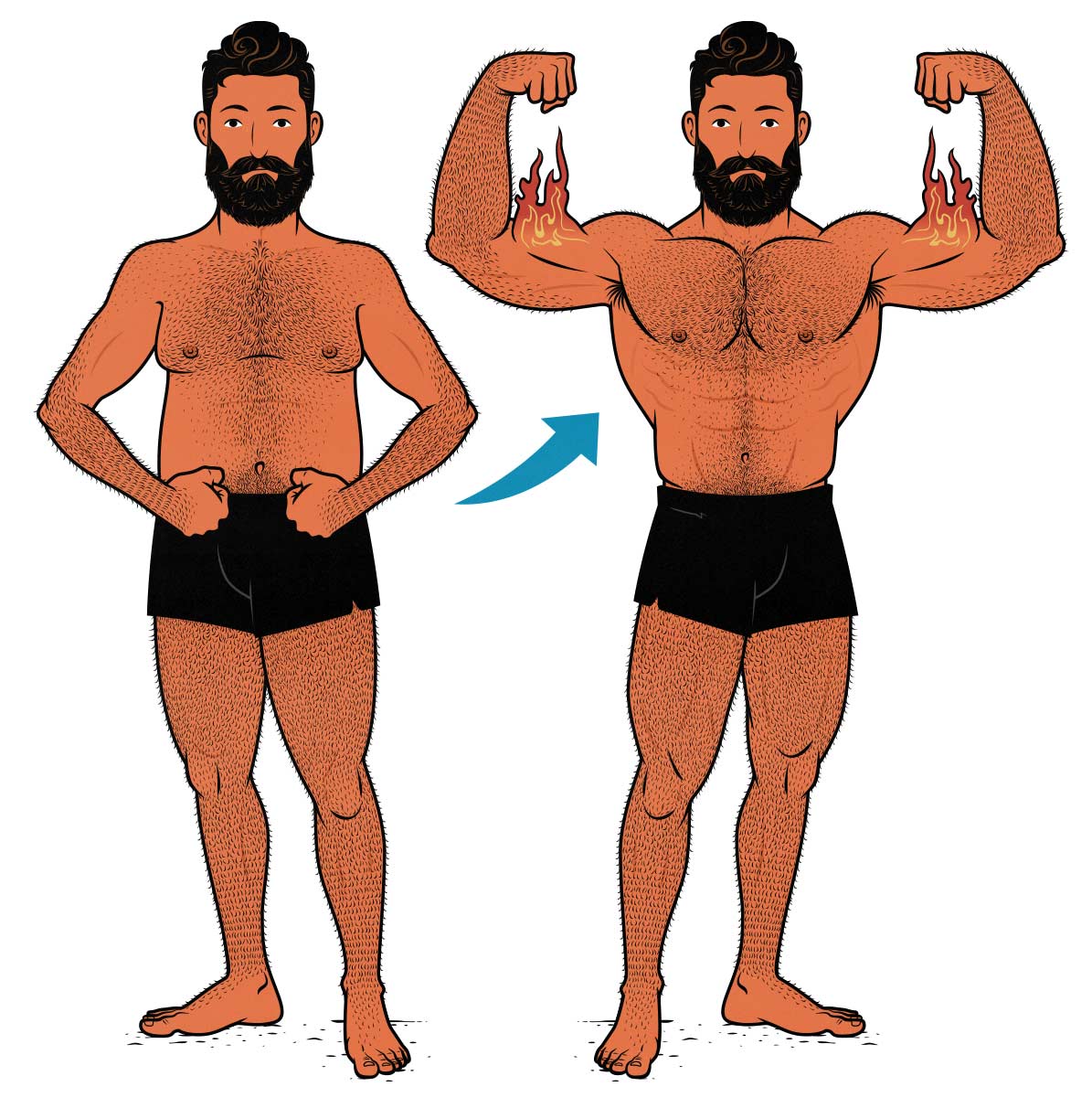
The Dumbbell Fly
The dumbbell fly is the exercise that brings the chest and biceps workout together. You don’t have to use it. You could use a mix of pressing exercises and biceps curls instead. But the dumbbell fly lets you train both your chest and biceps at the same time:
The dumbbell fly is one of the better chest exercises. It works your chest through a full range of motion, challenging your pecs under a deep stretch. That’s fantastic for building muscle.
Some people argue that the dumbbell fly suffers from having no tension at the top, when you’re holding the dumbbells above you, but that doesn’t really matter. You don’t need tension at the top. You’ll gain far more muscle and strength by biasing the bottom.
What makes the dumbbell fly interesting, though, is that it also works your biceps. When you lower the weight, you’re stretching out your biceps at the shoulder joint, working them through a deeper range of motion than you’d get from most biceps curls.
Your biceps need to fight to keep your elbows from opening all the way. They can also assist your chest and front delts in hugging the weight up. It’s a true biceps exercise.
You can reduce the tension on your biceps by keeping more of a bend in your elbows. You can increase the tension on your biceps by opening up your arms wider. I recommend starting with more of a bend, and then experimenting with opening them up as your biceps grow tougher.
The Lying Dumbbell Curl
The lying dumbbell curl is similar to the dumbbell fly, except instead of stabilizing the weight with your biceps while lifting with your chest, now you’re stabilizing with your chest while lifting with your biceps:
It’s handy to pair with the dumbbell fly because you can stay on the same bench for both exercises. You can probably use the same dumbbells for both exercises, too. Just be flexible with the rep range, doing as many reps as possible with the dumbbells you used for the dumbbell fly. If you get somewhere between 6–20 reps, that’s perfect.
The Pure Chest & Biceps Workout
The pure chest and biceps workout is perfect if you’re doing a Bro Split with a Chest Day, Back Day, Leg Day and Arm Day. If you train your biceps on Chest Day, that gives you extra biceps volume, and it also bumps up your biceps frequency to 3x per week:
- Monday: Biceps (and Chest)
- Tuesday: Legs
- Wednesday: Biceps (and Back)
- Thursday: Shoulders, Rest, or Cardio
- Friday: Biceps (and Arms)
- Saturday: Rest or Cardio
- Sunday: Rest or Cardio
That third biceps workout can be great for your biceps.
You could start the workout with dumbbell flyes, training your chest without stimulating your triceps. Extra triceps stimulation is usually a good thing, though, and I find flyes feel better after the chest is already a bit tired.
Here’s the workout. The links lead to tutorial videos of us teaching the exercises:
| Exercise | Sets | Reps |
|---|---|---|
| Bench Press | 3–5 | 6–12 |
| Curl-Bar Curl | 3–5 | 6–12 |
| Dumbbell Fly | 2–4 | 10–15 |
| Lying Dumbbell Curl | 2–4 | 6–20 |
| Hammer Curl | 2–4 | 10–15 |
Here’s why the workout is so effective:
- Bench Press: This is your big, heavy, compound chest exercise. You can swap it for the incline bench press, chest press machine, weighted dips, or push-ups.
- Curl-Bar Curl: This is your big, heavy, compound biceps exercise. You can swap it for barbell curls or dumbbell curls. It isn’t strictly necessary, either. You could go straight to the dumbbell fly.
- Dumbbell Fly: This is one of the rare exercises that trains both your chest and biceps at the same time. It works both your biceps and pecs under a deep stretch. It’s a great exercise.
- Lying or Standing Dumbbell Curl: Stay on the same bench you did your flyes on, get your pecs and biceps under a deep stretch, and curl the weight up with your biceps. If that’s too much for your biceps (or chest), you can do standing dumbbell biceps curls instead.
- Hammer Curl: This hits your brachialis (under your biceps) and brachioradialis (top of your forearm).
Just be mindful not to overdo it. If you aren’t used to training your biceps under a deep stretch, the stimulation might be too much, and you might get too sore. You might want to ease into it.
This workout is short and relatively easy, so you could add in some extra exercises. I like to add in some neck training and lateral raises. You could also add in ab exercises.
The Chest & Biceps Emphasis Workout
This is similar to the pure workout, but we’re adding a pulling exercise so that it becomes a full upper-body workout. This is the type of workout you could use in a four, five, or six-day Upper/Lower Split, giving your biceps and chest 2–3 good workouts per week.
I think this is a slightly better workout. Pressing and pulling exercises fit really well together, and your back will appreciate the extra training frequency (even if you trained it the day before). The workout isn’t quite as hard on your biceps, but that’s perfectly fine. Your biceps will be hammered more than hard enough, I promise.
| Exercise | Sets | Reps |
|---|---|---|
| Bench Press | 3–5 | 6–12 |
| Cable Row | 3–5 | 8–12 |
| Dumbbell Fly | 2–4 | 10–15 |
| Lying Dumbbell Curl | 2–4 | 6–20 |
| Hammer Curl | 2–4 | 10–15 |
| Lateral Raises | 2–4 | 10–15 |
Here’s why the workout is so effective:
- Bench Press: This is the main chest exercise. You can swap it for the incline bench press, chest press machine, weighted dips, or push-ups.
- Cable or Bent-Over Row: This is your main back exercise, and it also works your biceps a little bit. You can swap it for dumbbell rows, T-bar rows, or any other big rowing exercise.
- Dumbbell Fly: The dumbbell fly trains both your chest and biceps, and it trains them both under a deep stretch, stimulating a ton of growth.
- Lying or Standing Dumbbell Curl: Stay on the same bench you did your flyes on, get your pecs and biceps under a deep stretch, and curl the weight up with your biceps. If that’s too much for your biceps (or chest), you can do standing dumbbell biceps curls instead.
- Hammer Curl: This hits your brachialis (under your biceps) and brachioradialis (top of your forearm).
- Lateral Raises: This hits your side delts, rounding out your upper-body workout. You can do these standing or lying sideways on a bench (like this).
Just like with the last workout, be mindful not to overdo it. I’d start with two sets per exercise and build from there. I’d also start with more of a bend in your elbows while doing the dumbbell flyes.
Your biceps won’t fall off if you work them too hard, but you might stress them so much that they feel funny for a few hours and give you a few days of soreness. Better to keep the muscle damage more moderate (study).
Alright, that’s it for now. Drop a comment if you have any questions.
